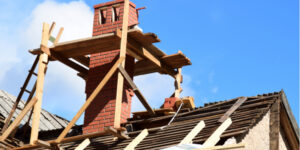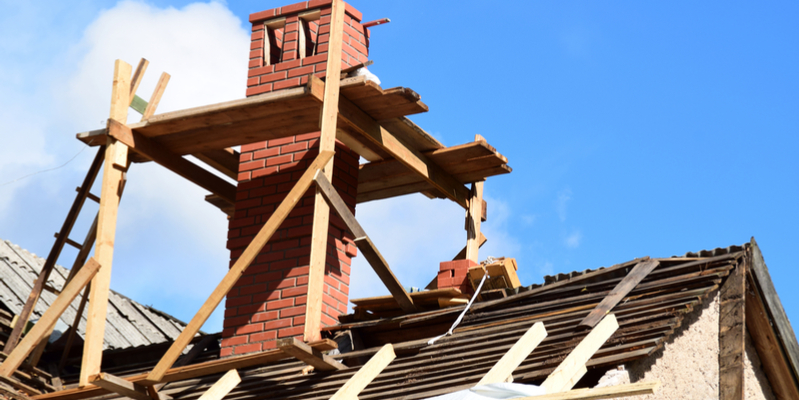Chimneys are a home’s most vulnerable part, and if they aren’t taken care of properly, they can lead to major damage or the need for a chimney rebuild.
The bricks and mortar in a chimney are exposed to deterioration as the weather and temperature change over time. This leads to a variety of Chimney Repair Reading PA issues.
The chimney crown plays a crucial role in the life of your chimney. It is a concrete slab that encloses the top of your chimney and forms a water-tight seal to keep rainwater out.
The crown also has a sloped drip edge to deflect water away from the chimney and flue liner, which helps prevent leaks into your home.
Unfortunately, the chimney crown can become damaged over time by foul weather, moisture exposure, and improper construction. These issues can shorten the lifespan of your chimney crown, which is why it’s important to schedule regular inspections.
Cracked crowns are the first sign that something is wrong with your chimney and should be addressed immediately. They can lead to a variety of problems, including chimney fires.
If you have a cracked chimney crown, your best bet is to hire a professional chimney repair company for help. They can apply a waterproof sealant to the crown and make repairs.
They can also apply a bond patching material if the cracks are too large to fill with sealant. This is a cost-effective way to deal with a cracked crown and can add years to the lifespan of your chimney.
A chimney contractor can also remove moss growth and dirt from the crown. This will help extend the lifespan of the crown and improve airflow in your chimney.
To prepare for a crown repair, clean the chimney crown thoroughly with a stiff poly or nylon brush. Next, chip off any small loose pieces of mortar and debris that are close to the flue liner.
You should also inspect the bricks for any signs of damage or decay. If there are cracks or chips in the bricks, it’s a sign that moisture is entering the chimney.
Another sign of a problem is the presence of rust inside the chimney. This is a sign of moisture damage, and it’s usually found near the flue lining, where water can enter the chimney and cause damage.
To prevent this, make sure you have a properly designed chimney and use proper building materials for your chimney crown. Chimney crowns should be made from concrete, not mortar, to withstand fluctuations in temperature and harsh weather. They should extend at least two inches past the outside chimney wall and contain a drip edge underneath.
When a chimney repair is done, it can cause spalling bricks to appear on the chimney. This can be a very serious issue that needs to be addressed immediately. Not only does it look bad, but it also allows water to enter your home and can cause problems with your roof or even within the fireplace itself.
Spalling bricks are usually a result of an issue with the mortar joints on your chimney. These joints are designed to hold the bricks together in a way that prevents them from falling off. If the mortar becomes weak and breaks down, it’s impossible for the bricks to support each other.
This can lead to the entire chimney being weaker and more likely to fall down. It can also put the safety of your family at risk.
In order to fix the problem of spalling bricks, you’ll need to assess the entire chimney and find out where the leaks are coming from. You’ll also need to determine how many bricks are crumbling and what caused them to do so.
Identifying the root cause is critical to getting this problem fixed and will save you money down the road. This is especially true if the issue isn’t caused by a leaking cap or crown but rather a crack in the masonry.
Once you’ve identified the damage, make sure to fix the leaks and replace the bricks that are crumbling. You’ll want to use replacement bricks that match your existing ones and make sure you do a good job of repairing the mortar between them.
The best time to do this is before winter comes so that the bricks aren’t exposed to snow and ice. It’s important to note that the cold weather will cause water to expand inside the masonry, which can quickly erode the bricks and leave them vulnerable to further damage.
It’s also a good idea to ensure that the bricks you’re using are quality. Poor-quality salvaged bricks tend to be more susceptible to moisture and will start to show signs of spalling much faster than top-quality bricks.
A leaking flue is not something that you want to have happen. It can be dangerous and potentially lead to a chimney fire. It also can expose you to toxic carbon monoxide and other dangerous gases that could cause health problems.
A chimney flue is a channel that carries the gas from a fireplace or other heating appliance out of your home. These flues can be made from terra cotta clay or stainless steel and are installed to ensure that the smoke and fumes leave your home safely without creating a problem inside your house.
The chimney flue needs to be inspected and cleaned regularly. If the flue becomes damaged, it can become clogged with creosote, and this can lead to a chimney fire.
Moisture can also leak into the chimney flue and cause damage. This can happen through cracked caps, porous masonry, and poor mortar joints.
It can also be caused by faulty flashing that was installed incorrectly, or that has rusted and lifted from the roof. Luckily, there are more effective flashing materials that can be used now to seal and protect your chimney from water.
Another possible source of moisture entering your chimney is a crack in the crown. The crown is a cement surface that wraps around the top of your chimney, and it acts like a rain guard to keep moisture from getting in between your masonry and your flue liner.
If the crown becomes cracked, it will no longer protect your chimney from water, and this can make the entire chimney a lot more vulnerable to water. This is why it’s important to have your chimney repaired as soon as possible so you don’t have to deal with this issue in the future.
Besides causing the chimney to leak, it can also damage the masonry and other parts of your home. In addition, a cracked flue liner can leak hot gasses that could cause the masonry to burn and start a chimney fire.
A leaking flue can also result in water entering your attic which can cause significant damage to your home and your family’s safety. If this happens, you will have to hire a professional who can repair the damage before it can get worse.
A chimney is a crucial feature of a home, but it can be damaged by a variety of factors. Some of the most common issues include cracking masonry, leaking flues, and spalling bricks. If you notice any of these problems, it’s important to take immediate action.
If a homeowner spots a crack in the brick or mortar, it’s usually an early warning sign that something needs to be fixed. This can save you thousands of dollars in repairs later on.
The mortar between the bricks is an essential part of a chimney that prevents water from escaping into your home. It also provides the necessary bonding for the bricks to stay together, preventing them from shifting and causing damage.
When the masonry in a chimney cracks, it can cause severe water damage and even structural damage. As water seeps in and through the joints, it causes freeze and thaw cycles to break down the mortar.
Damp masonry isn’t necessarily a big issue, but when a chimney has freeze/thaw damage, it can be devastating. In addition, water that’s trapped in a chimney during the freezing process expands more than it should, turning small cracks into larger ones.
As a result, it’s not uncommon for the mortar between a pair of bricks to completely crumble away, revealing a gap in the wall that allows moisture to enter your home. Thankfully, this can easily be corrected by a simple repair known as tuckpointing.
To repoint the joints in between your bricks, you’ll need to apply mortar dyed to match the color of the surrounding bricks. Once you’ve applied enough mortar to cover the opening, gouge a V-groove in the middle of the joint and allow it to be partially set.
Once the joint is firm but still pliable, use a mortar finishing tool to drag through it and smooth it out. This can be done with a hand trowel or a pointing trowel.
For a more permanent fix, consider a brush-applied crack filler that stays flexible to minimize leaks and keep water out of the bricks themselves. This product is designed to seal cracks up to 1/8” wide and dries clear to milky white, depending on the size of the crack.

